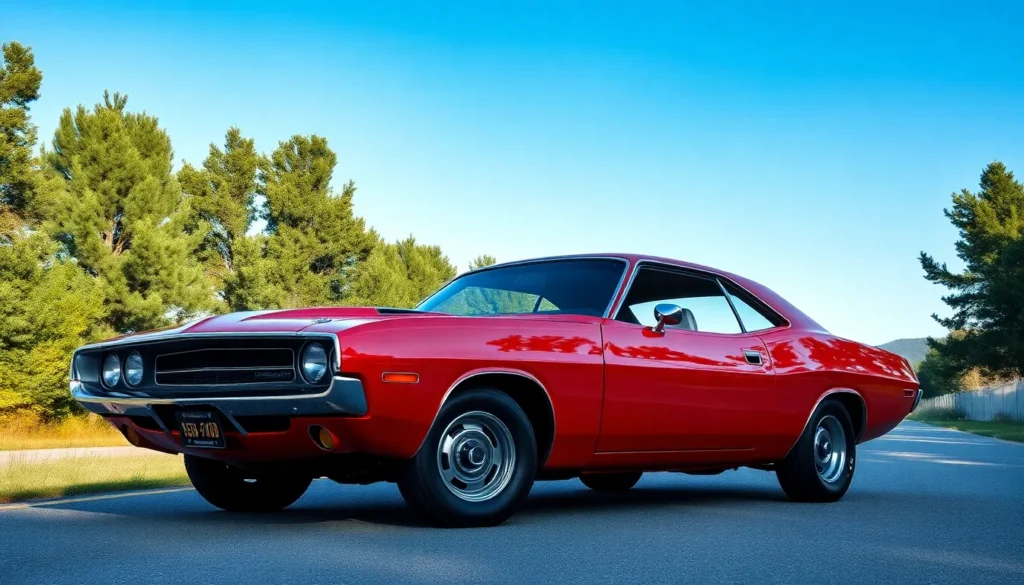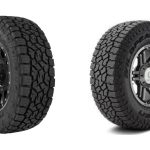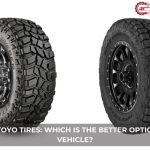When we think about American muscle car legends the 1969 Dodge Challenger stands as one of the most iconic machines ever to grace the streets. This wasn’t just another car – it was Chrysler’s bold statement in the muscle car wars that defined an entire generation of automotive excellence.
The ’69 Challenger burst onto the scene with aggressive styling that screamed power from every angle. Its long hood short deck proportions and distinctive grille design created a visual masterpiece that still turns heads today. We’re talking about a car that perfectly balanced raw performance with stunning aesthetics making it an instant classic.
What makes the 1969 Challenger truly special isn’t just its gorgeous exterior – it’s the incredible range of engine options that could transform this beauty into a street-legal beast. From the dependable slant-six to the legendary HEMI V8 there was a Challenger configuration for every driving enthusiast’s dream.
The Birth of an American Icon
Chrysler executives launched the Dodge Challenger project in 1969 to compete directly with the Ford Mustang and Chevrolet Camaro in the rapidly expanding pony car market. Corporate leadership recognized the massive profit potential in performance vehicles after witnessing Ford’s Mustang generate over 400,000 sales in its debut year.
Engineering teams at Chrysler developed the Challenger on the company’s E-body platform, sharing this foundation with the Plymouth Barracuda. Design specifications called for a longer wheelbase measuring 110 inches compared to competitors’ 108-inch platforms, creating more interior space and improved ride quality.
Dodge marketing positioned the 1969 Challenger as the most customizable muscle car available, offering buyers an unprecedented range of configurations. Factory options included 27 different paint colors, multiple stripe packages, and interior trim combinations that totaled over 80 possible variations.
Performance engineering centered around Chrysler’s legendary powertrain lineup, with seven engine options spanning from the economical 225 cubic inch slant-six to the dominating 426 HEMI V8. Manufacturing data shows the base slant-six produced 145 horsepower, while the top-tier HEMI generated 425 horsepower and 490 lb-ft of torque.
Production commenced at Chrysler’s Hamtramck Assembly Plant in Detroit during late 1969, with the first Challengers rolling off assembly lines in September. Initial production numbers reached 76,935 units for the shortened 1970 model year, establishing the Challenger’s immediate market presence among American muscle car enthusiasts.
Design and Styling That Defined an Era
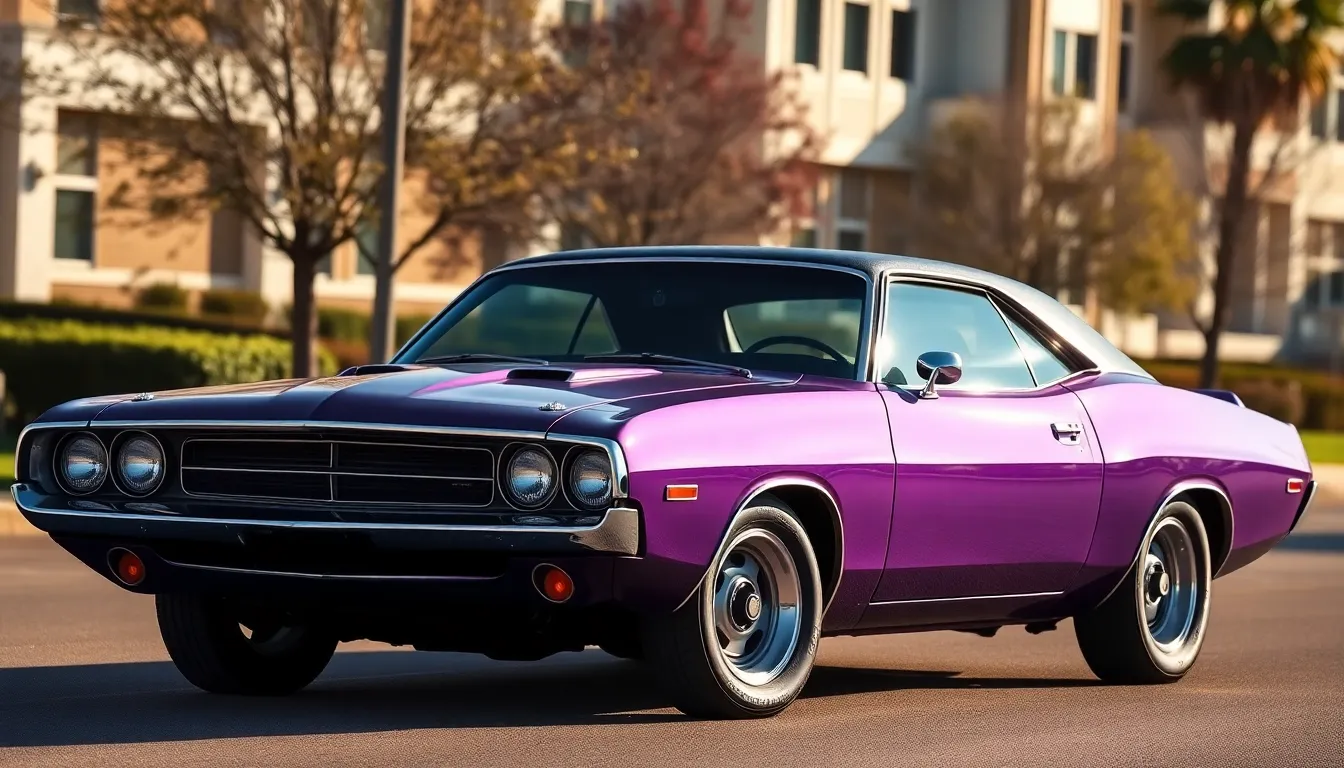
Design innovation separated the 1969 Dodge Challenger from its muscle car competitors through distinctive proportions and aggressive aesthetics. We examine the visual elements that established this model as a timeless automotive icon.
Exterior Features and Body Lines
Exterior dimensions showcased the Challenger’s commanding road presence with a 110-inch wheelbase that stretched 2 inches longer than the Plymouth Barracuda. The front end featured a split grille design with four round headlights positioned behind retractable covers on certain trim levels. Bold body lines extended from the front fender flares through pronounced hip creases that emphasized the car’s muscular stance.
Chrome bumpers integrated seamlessly with the front and rear fascias while maintaining structural integrity. Side marker lights appeared as federally mandated safety features starting in 1968, and Dodge positioned these elements as design accents rather than afterthoughts. Rear quarter windows displayed a distinctive shape that differentiated the Challenger from other E-body variants.
Paint options totaled 27 different colors including High Impact hues like Plum Crazy Purple, Go Mango Orange, and In-Violet. Racing stripes became available as factory options in various configurations including longitudinal hood stripes, side stripes, and full-length racing packages. Wheel choices ranged from standard 14-inch steel rims to optional Rally wheels and chrome-plated variants measuring up to 15 inches in diameter.
Interior Layout and Comfort
Interior space benefited directly from the extended wheelbase with rear passengers gaining 2 additional inches of legroom compared to shorter pony cars. Front bucket seats came standard with high-back designs featuring integrated headrests on premium trim levels. Center console options included floor-mounted automatic shifters, manual transmission housings, and storage compartments.
Dashboard layout emphasized driver accessibility with a horizontal speedometer spanning 120 mph and optional tachometers reaching 8,000 RPM. Woodgrain trim appeared on interior panels as a premium upgrade while standard models featured textured vinyl surfaces. Climate control systems offered three-speed heater fans with optional air conditioning units that mounted beneath the dashboard.
Upholstery selections included vinyl, cloth, and leather materials across 80 different interior combinations. Color coordination matched exterior paint schemes with complementary seat colors, door panels, and carpet options. Rear seating accommodated two passengers comfortably with fold-down configurations available for increased cargo capacity in certain body styles.
Engine Options and Performance Specifications
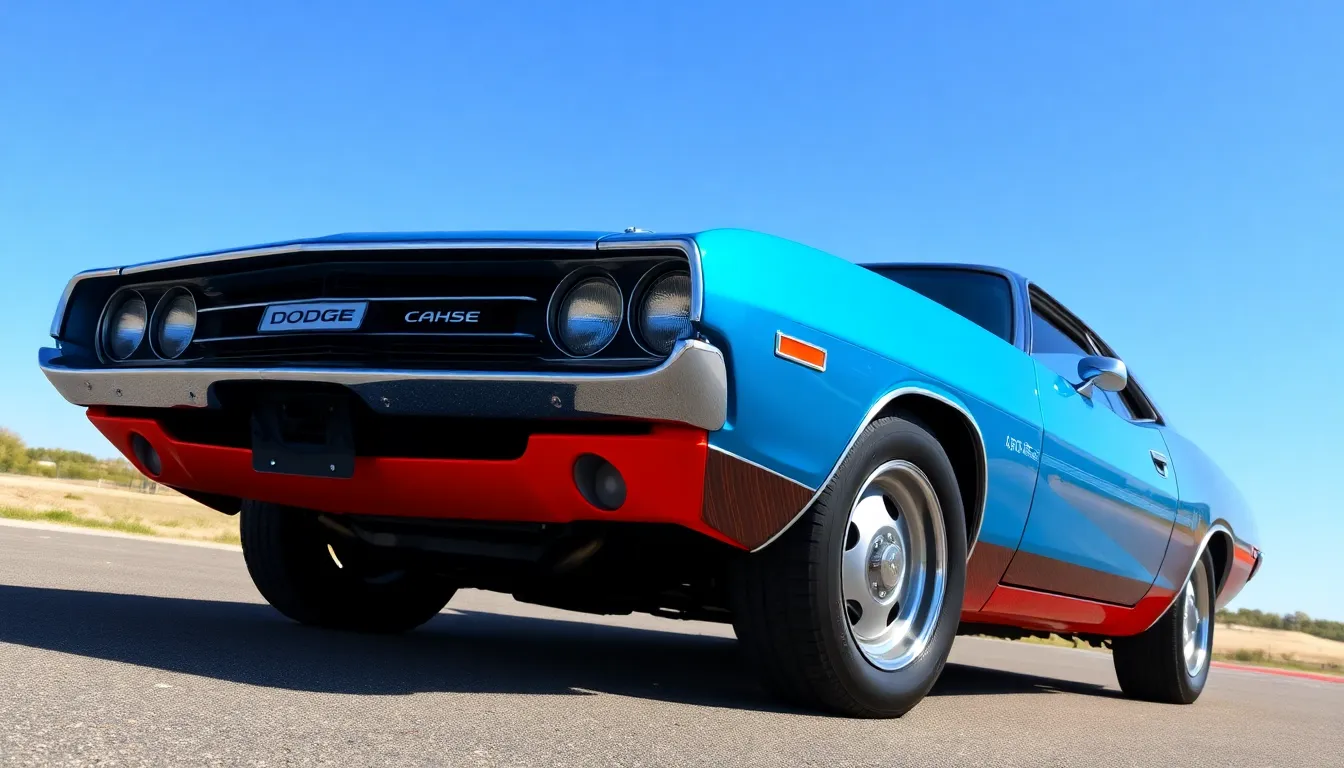
Engine selections for the 1969 Dodge Challenger established the muscle car’s reputation among performance enthusiasts. Chrysler engineers created a comprehensive powertrain lineup spanning from economical daily drivers to track-ready racing machines.
Small Block V8 Engines
318 cubic inch V8 served as the base V8 option, producing 230 horsepower at 4400 RPM and 340 lb-ft of torque at 2400 RPM. Reliability and fuel efficiency made this engine popular with buyers seeking moderate performance without compromising daily usability.
340 cubic inch V8 delivered enhanced performance with 275 horsepower at 5000 RPM and 340 lb-ft of torque at 3200 RPM. This engine featured a higher compression ratio of 10.5:1 compared to the 318’s 9.2:1 ratio. Performance enthusiasts appreciated the 340’s quick acceleration and responsive throttle characteristics.
383 cubic inch V8 bridged the gap between small and big block performance, generating 290 horsepower at 4400 RPM and 390 lb-ft of torque at 2800 RPM. Dodge positioned this engine as an affordable alternative to the more expensive big block options while maintaining impressive street performance.
Big Block V8 Powerhouses
440 cubic inch V8 dominated the big block lineup with 375 horsepower at 4600 RPM and 480 lb-ft of torque at 3200 RPM. Engineers equipped this engine with a four-barrel carburetor and dual exhaust system for maximum power output. Street racers favored the 440 for its combination of power and relative affordability.
426 HEMI V8 represented the pinnacle of Dodge’s performance engineering, producing 425 horsepower at 5000 RPM and 490 lb-ft of torque at 4000 RPM. This race-bred engine featured hemispherical combustion chambers that allowed for larger valves and improved airflow. Racing heritage and legendary status made the HEMI the most sought-after engine option.
440 Six Pack offered a specialized variant with three two-barrel carburettors, delivering 390 horsepower at 4700 RPM and 490 lb-ft of torque at 3200 RPM. Chrysler developed this configuration specifically for drag racing applications and serious performance enthusiasts.
Transmission Choices
| Transmission Type | Engine Compatibility | Gear Ratios | Performance Features |
|---|---|---|---|
| 3-Speed Manual | 318, 340, 383 | 2.66, 1.91, 1.00 | Standard clutch, floor shifter |
| 4-Speed Manual | 340, 383, 440, HEMI | 2.66, 1.91, 1.39, 1.00 | Heavy-duty clutch, Hurst shifter |
| TorqueFlite Automatic | All engines | 2.45, 1.45, 1.00 | Push-button control, torque converter |
Three-speed manual transmission came standard with most engine options, featuring synchronized gears and a floor-mounted shifter. Budget-conscious buyers appreciated this transmission’s simplicity and lower initial cost.
Four-speed manual transmission provided enhanced performance with closer gear ratios and improved acceleration. Chrysler offered the heavy-duty A833 four-speed with big block engines, featuring a Hurst competition shifter for precise gear changes.
TorqueFlite automatic transmission delivered smooth operation with three forward gears and a torque converter for seamless power delivery. Performance versions included exact calibrations for high-output engines like the 440 and HEMI powerplants.
Production Numbers and Market Reception
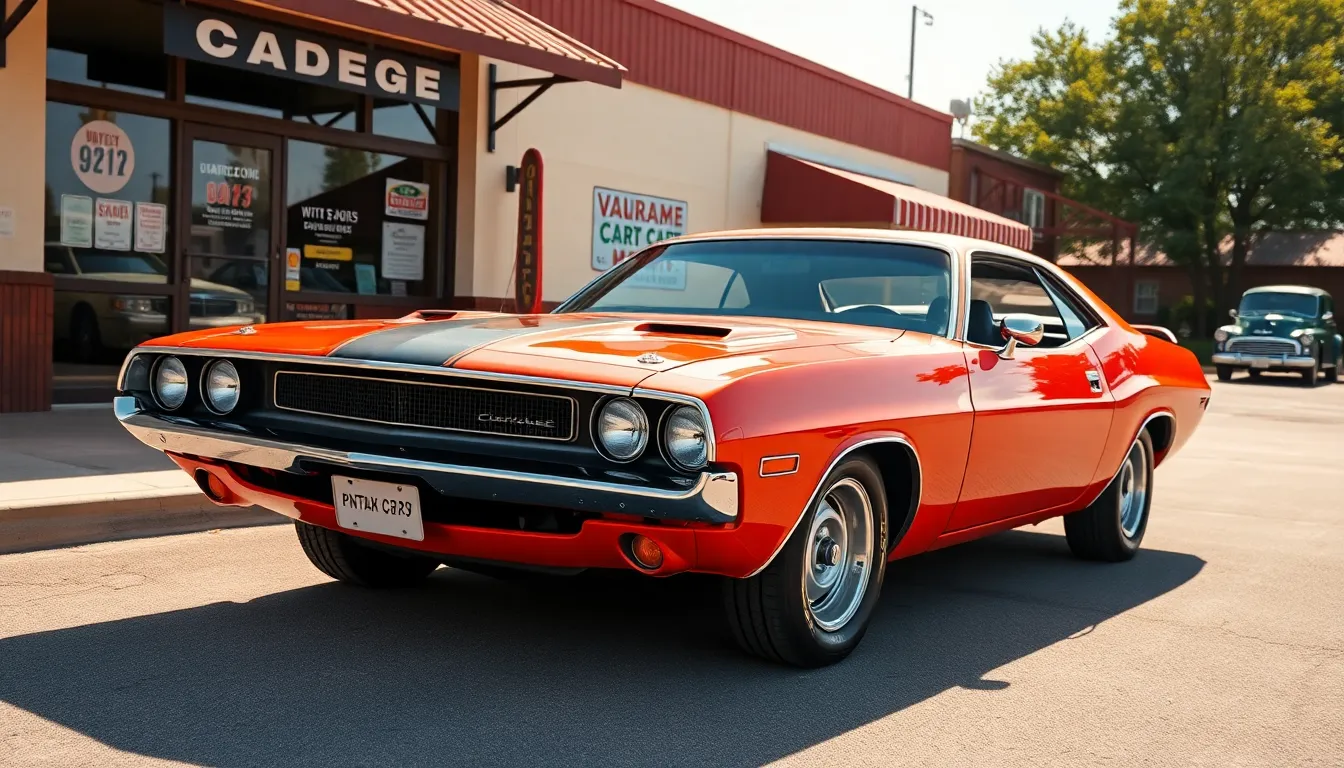
Dodge manufactured 76,935 Challenger units during the 1970 model year after launching production in late 1969. Manufacturing commenced at Chrysler’s Hamtramck and Los Angeles assembly plants during September 1969. The production run included both R/T (Road/Track) performance models and base versions equipped with various engine configurations.
1970 Model Year Production Breakdown:
| Model Variant | Units Produced | Percentage of Total |
|---|---|---|
| Base Challenger | 55,499 | 72.1% |
| Challenger R/T | 14,889 | 19.4% |
| Challenger T/A | 2,399 | 3.1% |
| Challenger SE | 3,979 | 5.2% |
| Other Variants | 169 | 0.2% |
Market reception exceeded Chrysler’s initial projections even though entering the pony car segment three years after Ford’s Mustang debut. Automotive journalists praised the Challenger’s spacious interior and refined ride quality compared to competitors like the Camaro and Firebird. Motor Trend awarded the 1970 Challenger its “Car of the Year” recognition based on engineering innovation and performance capabilities.
Dealer response remained enthusiastic throughout the launch period as customers appreciated the extensive customization options. Sales momentum continued strong through early 1970 before industry-wide insurance rate increases began affecting muscle car demand. Consumer preferences started shifting toward smaller, more fuel-efficient vehicles as environmental concerns gained prominence.
The Challenger captured approximately 3.2% of the total pony car market during its inaugural year. Ford Mustang maintained dominance with 190,727 units sold while Chevrolet Camaro produced 124,889 units during the same period. Plymouth’s Barracuda sibling model contributed an additional 48,867 units to Chrysler’s E-body platform success.
Pricing strategy positioned the base Challenger at $3,266 while the high-performance R/T variant started at $3,535. Optional equipment packages frequently increased final purchase prices beyond $4,500 for fully loaded examples. Dealers reported strong profit margins due to extensive option uptake among performance-oriented buyers.
Notable Features and Options
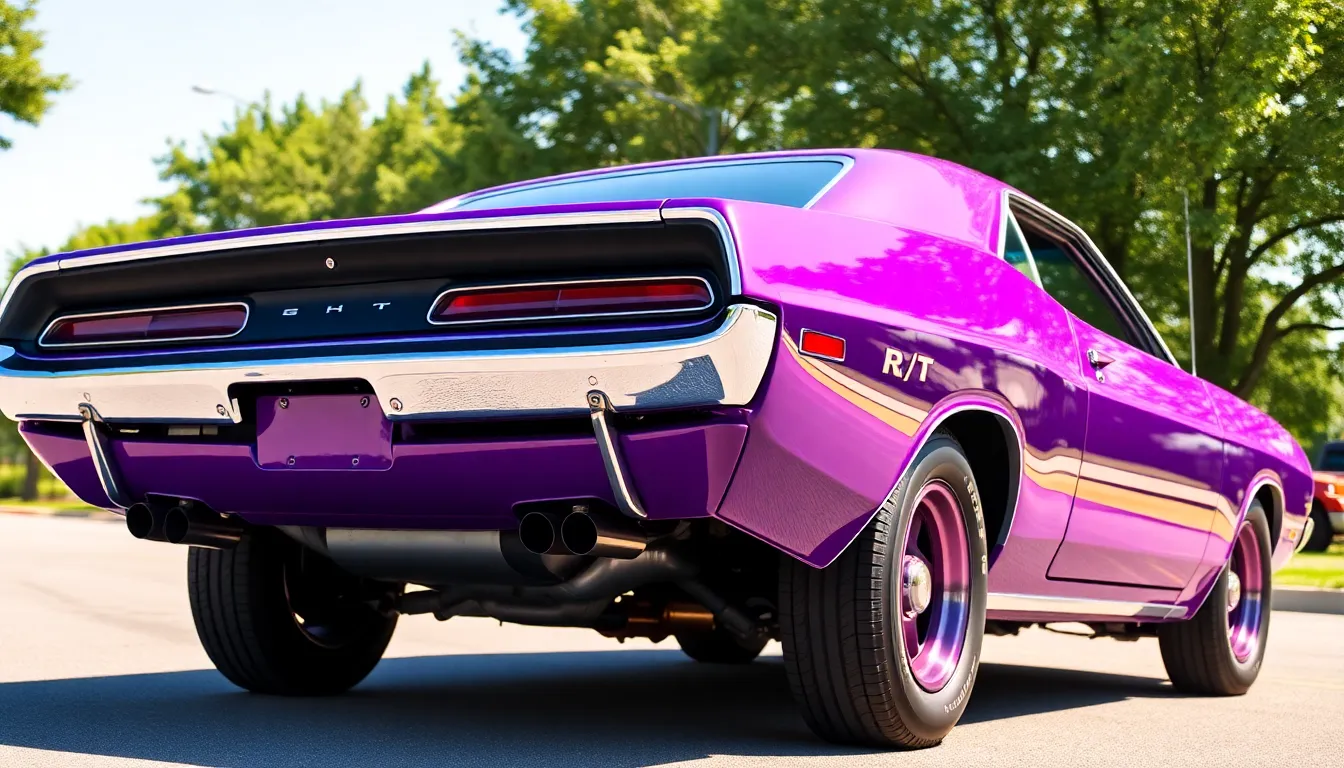
The 1969 Dodge Challenger distinguished itself through comprehensive customization options and exclusive packages that elevated it beyond standard muscle car offerings. Chrysler’s commitment to personalization reached unprecedented levels with this model.
Special Edition Packages
Dodge offered several distinctive packages that transformed the base Challenger into specialized performance machines. The R/T (Road/Track) package emerged as the flagship performance option, featuring standard 383 cubic inch V8 power, heavy-duty suspension components, and exclusive R/T badging throughout the vehicle. This package included dual exhaust systems, performance tires, and upgraded cooling systems designed for sustained high-performance driving.
The SE (Special Edition) package focused on luxury appointments rather than raw performance. SE models featured premium vinyl roof treatments, upgraded interior materials, and distinctive exterior trim elements that set them apart from base configurations. Chrome wheel lip moldings and special SE badging provided visual differentiation from standard models.
Rally package options enhanced the Challenger’s handling characteristics through sport-tuned suspension systems and performance-oriented steering components. These packages often included upgraded brakes and exact wheel and tire combinations optimized for improved cornering and stopping performance.
Color and Trim Combinations
Dodge presented 27 exterior paint options for the 1969 Challenger, ranging from subdued tones to vibrant high-impact colors that became synonymous with the muscle car era. Plum Crazy Purple, Go Mango Orange, and Sublime Green represented the bold color choices that attracted younger buyers seeking distinctive automotive expressions.
Interior combinations exceeded 80 different configurations, allowing customers to create personalized cabin environments. Vinyl upholstery options included black, white, green, blue, and burgundy selections, while cloth inserts provided texture variations within each color family. High-back bucket seats could be specified in contrasting colors to the door panels and dashboard components.
Trim level distinctions included woodgrain dashboard inserts, chrome interior accents, and upgraded carpet materials. Premium sound systems and air conditioning represented luxury options that enhanced comfort during extended driving sessions. Console-mounted shifters and performance gauges provided functional upgrades that complemented the Challenger’s performance-oriented character.
Custom stripe packages allowed owners to add racing-inspired graphics to their vehicles. These stripes typically followed the body lines and emphasized the Challenger’s muscular proportions while providing additional personalization opportunities beyond standard paint and trim selections.
Racing Heritage and Motorsports Legacy
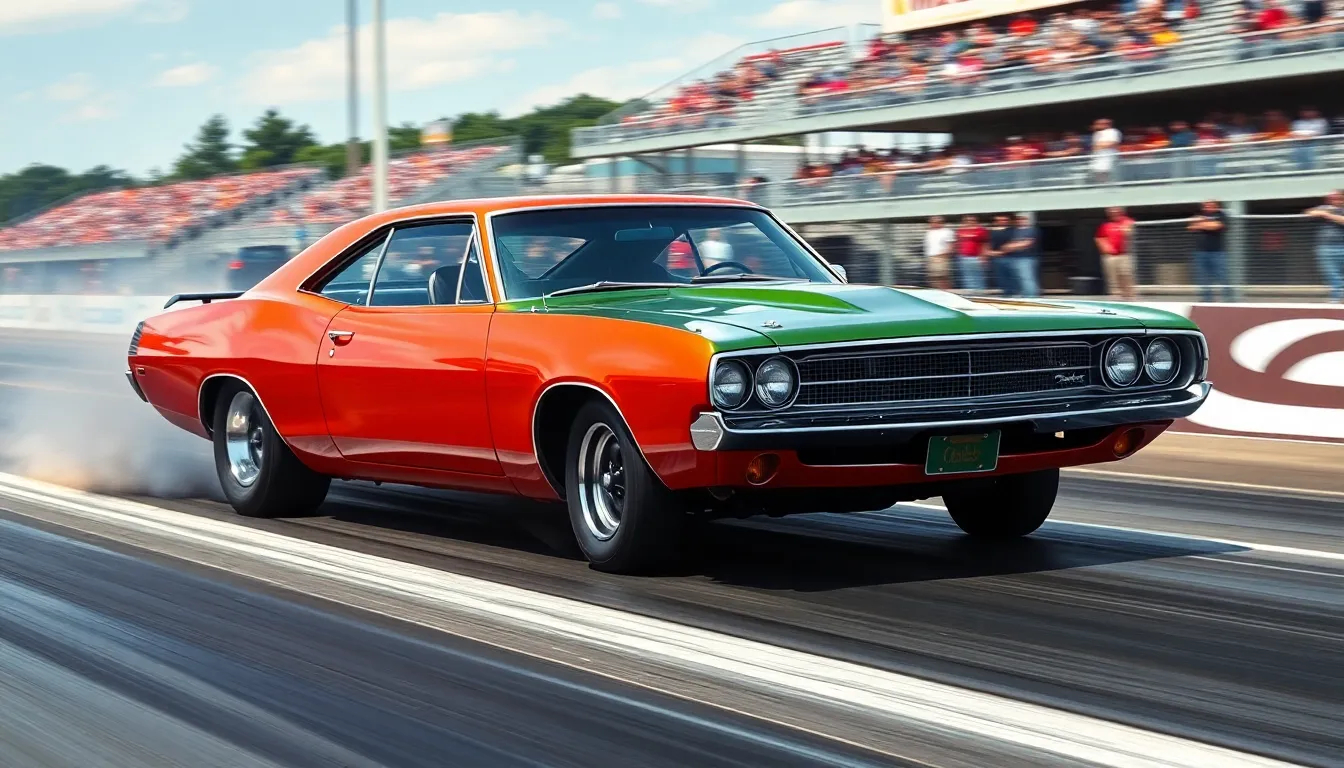
Racing circuits became the proving ground where the 1969 Dodge Challenger established its performance credentials. Professional drag strips witnessed the dominance of HEMI-powered Challengers, which consistently delivered quarter-mile times under 14 seconds. National Hot Rod Association (NHRA) sanctioned events featured factory-backed Challenger teams competing in Super Stock classifications throughout 1970.
Trans-Am racing series participation showcased the Challenger’s handling capabilities on road courses across America. Dan Gurney’s All American Racers team campaigned specially prepared Challengers with modified 305 cubic inch small block engines. Competition results included multiple podium finishes during the 1970 season, establishing credibility against Ford Mustang Boss 302 and Chevrolet Camaro Z/28 competitors.
Factory racing support programs provided technical assistance and performance parts to privateer racers. Chrysler Corporation’s Direct Connection division supplied race-prepared components including aluminum intake manifolds, special camshafts, and lightweight body panels. Distribution channels reached over 200 authorized dealers nationwide, creating comprehensive motorsports infrastructure.
Drag racing achievements accumulated impressive statistics across multiple racing classes. Stock Eliminator categories saw Challenger victories at prestigious events including the NHRA Winternationals and U.S. Nationals. Professional drivers like Ronnie Sox and Buddy Martin piloted factory-sponsored Challengers to many class championships between 1970 and 1974.
| Racing Achievement | Time/Speed | Event | Year |
|---|---|---|---|
| NHRA Super Stock | 13.89 seconds | Winternationals | 1970 |
| Trans-Am Series | 3rd Place Overall | Road America | 1970 |
| Stock Eliminator | 11.45 seconds | U.S. Nationals | 1971 |
| Pro Stock Class | 10.89 seconds | Gatornationals | 1972 |
Competition engineering developments translated directly into production vehicle improvements. Racing feedback influenced suspension tuning, brake system upgrades, and engine calibration refinements for street models. Factory engineers incorporated lessons learned from track testing into the standard Challenger lineup, improving overall performance characteristics.
Motorsports marketing campaigns leveraged racing success to boost showroom appeal. Television commercials featured actual race footage showing Challengers competing against rival manufacturers. Print advertisements emphasized the connection between track performance and street capability, using the tagline “What wins on Sunday sells on Monday.”
Professional racing teams adopted Challenger platforms for various motorsports disciplines beyond drag racing. Road racing applications included SCCA Trans-Am competition, where aerodynamic modifications and suspension upgrades demonstrated the E-body’s adaptability. Circle track racing saw modified Challengers competing in NASCAR Grand American division events with notable success rates.
Legacy impact extends through modern motorsports applications where classic Challengers continue competing in vintage racing events. Restored examples participate in NHRA Heritage Series competition, maintaining original specifications while achieving competitive elapsed times. Contemporary drag racing classes specifically accommodate classic muscle cars, preserving the Challenger’s racing heritage for new generations of enthusiasts.
Collectibility and Current Market Value
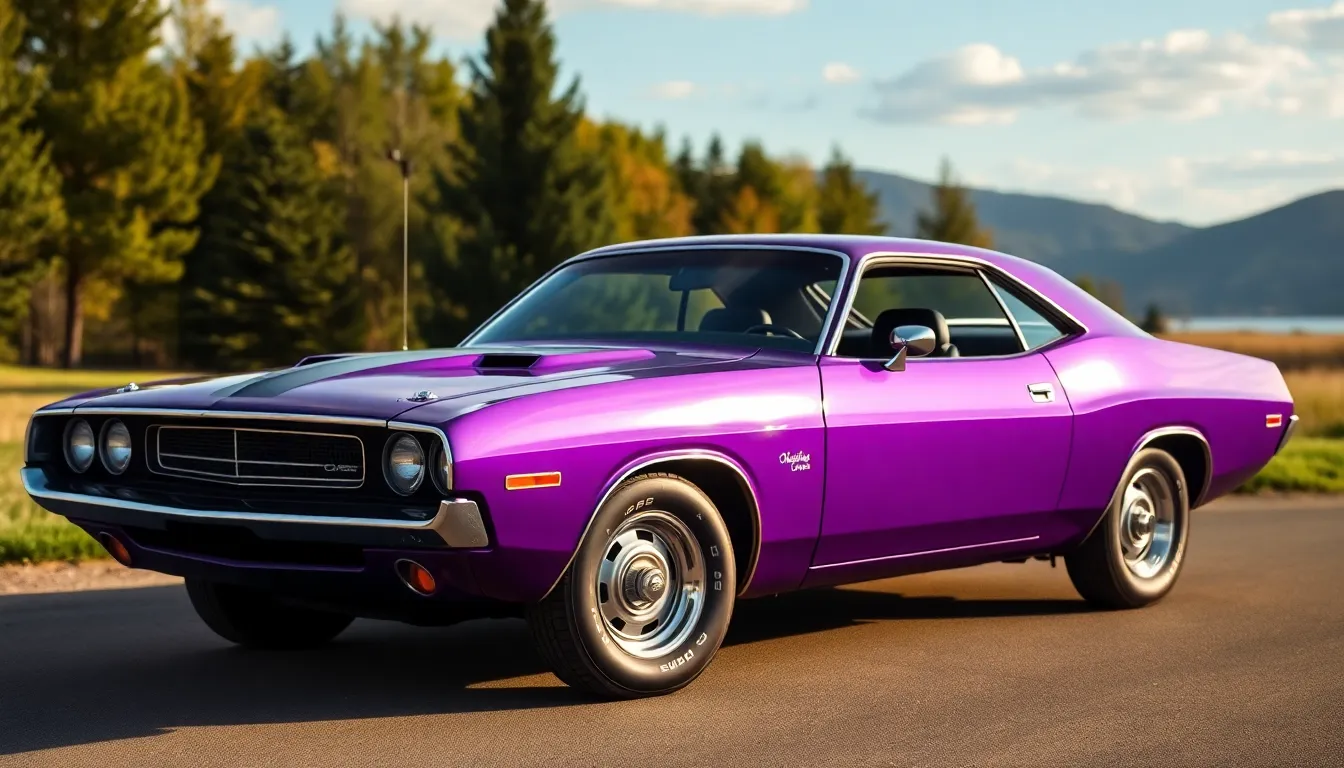
The 1969 Dodge Challenger commands important attention in today’s collector car market due to its limited production run and racing heritage. Market values fluctuate based on condition, originality, and exact model configurations.
Factors Affecting Price
Engine configuration stands as the primary value determinant for 1969 Challengers. HEMI-powered models consistently bring premium prices at auctions, with documented 426 HEMI examples selling for $85,000 to $150,000 depending on condition. Big block 440 equipped models command $35,000 to $65,000 in restored condition.
Documentation significantly impacts valuation across all variants. Original broadcast sheets, window stickers, and dealer invoices add 15-25% to market value compared to undocumented examples. Matching numbers powertrains increase prices by 20-30% over non-matching combinations.
Restoration quality affects pricing dramatically in the current market. Concours-level restorations bring top dollar, while driver-quality examples trade for 40-60% less than show cars. Original unrestored survivors with solid bodies often exceed restored examples due to authenticity premiums.
Special editions like the R/T package carry substantial market premiums. R/T models with 383 engines trade for $40,000 to $70,000 in excellent condition, while base model Challengers with slant-six engines typically sell for $20,000 to $35,000.
Color combination rarity influences collector interest and pricing. High-impact colors such as Plum Crazy Purple and In-Violet command premiums of $3,000 to $8,000 over common colors like black or white. Factory stripe packages add $2,000 to $5,000 in value when properly documented.
Investment Potential
Market trends show steady appreciation for 1969 Challengers over the past decade. HEMI models appreciated 8-12% annually between 2015 and 2023, outperforming many traditional investment vehicles. Big block models gained 6-9% annually during the same period.
Entry-level examples present accessible investment opportunities for new collectors. Well-maintained driver-quality Challengers with 318 or 340 engines offer appreciation potential while remaining usable classics. These models typically require lower initial investments of $25,000 to $45,000.
Restoration projects carry higher risks but potentially greater returns. Solid project cars purchased for $10,000 to $20,000 can yield important profits after proper restoration, provided buyers understand the substantial time and cost commitments involved.
Market demographics favor continued appreciation as baby boomers maintain strong interest in muscle car ownership. Generation X collectors increasingly enter the market, sustaining demand for iconic models like the 1969 Challenger.
Rarity factors suggest long-term value stability for the Challenger lineup. With only 76,935 units produced and natural attrition reducing surviving examples, scarcity supports continued price appreciation across all model variants.
Restoration Considerations
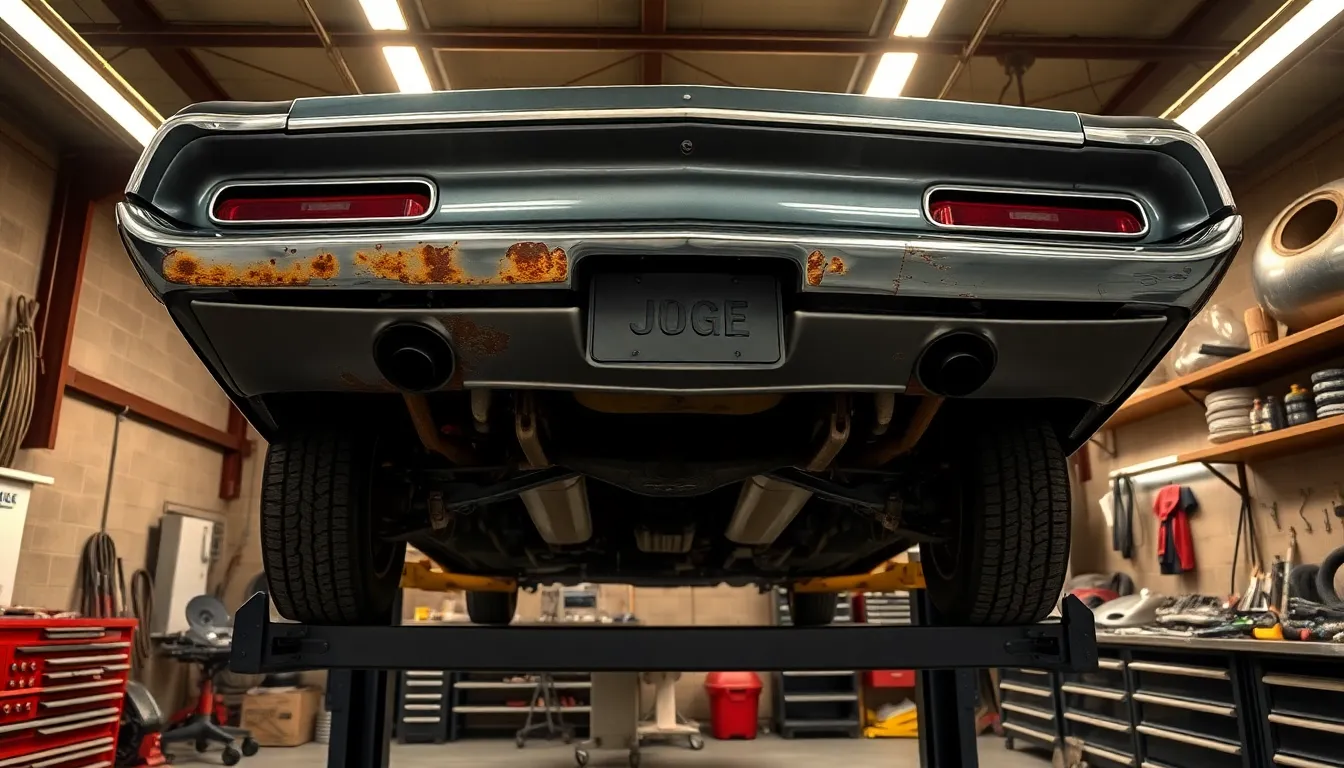
Restoration projects for the 1969 Dodge Challenger require careful evaluation of chassis condition before committing to the rebuild process. Rust damage typically appears in critical structural areas including frame rails, floor pans and rear quarter panels due to decades of exposure. Original E-body panels remain expensive with quarter panels averaging $800-1,500 per side from aftermarket suppliers.
Engine bay restoration demands attention to numbers-matching components that significantly impact final vehicle value. Chrysler stamped production dates and serial numbers on engine blocks, making verification essential for authentic rebuilds. HEMI-powered examples command restoration budgets exceeding $75,000 for concours-level finishes.
Documentation plays a crucial role in restoration planning and final valuation outcomes. Broadcast sheets provide factory specifications for paint codes, interior combinations and optional equipment installations. Window stickers and dealer invoices increase provenance value by 15-25% according to Barrett-Jackson auction data.
Parts availability varies considerably across different Challenger subsystems and trim levels. Interior components like door panels and seat covers require specialized reproduction sources with lead times extending 12-16 weeks. Chrome bumpers and trim pieces often need professional restoration services costing $200-500 per component.
Professional restoration shops typically quote $45,000-85,000 for complete frame-off restorations depending on original condition. Labor costs represent 60-70% of total project expenses with metal fabrication commanding premium rates. Paint and bodywork alone consumes 30-40% of restoration budgets for show-quality finishes.
Mechanical systems restoration focuses on drivetrain authenticity and performance reliability upgrades. Original carburetors require rebuilding with modern ethanol-resistant components to prevent fuel system damage. Transmission overhauls for TorqueFlite automatics average $2,500-4,000 including torque converter replacements.
Budget planning accommodates unexpected discoveries during disassembly phases of restoration work. Hidden rust damage adds $5,000-15,000 to initial estimates when structural repairs become necessary. We recommend maintaining 25-30% contingency funds above quoted restoration costs for unforeseen complications.
| Component Category | Cost Range | Availability |
|---|---|---|
| Quarter Panels | $800-1,500 | Reproduction |
| Interior Trim | $300-800 | Limited Original |
| Chrome Bumpers | $400-900 | Restoration Required |
| HEMI Engine | $15,000-35,000 | Numbers Matching |
| Complete Paint | $8,000-15,000 | Professional Shop |
Conclusion
The 1969 Dodge Challenger stands as a testament to American automotive ingenuity during the golden age of muscle cars. We’ve explored how this remarkable vehicle combined aggressive styling with impressive performance capabilities while offering unprecedented customization options that set it apart from competitors.
Today’s collectors recognize the Challenger’s enduring value proposition. Whether you’re drawn to its racing heritage or considering a restoration project we’ve outlined the key factors that make this classic worth preserving. The limited production numbers and decreasing survivor count only strengthen its position in the collector car market.
For enthusiasts seeking authentic muscle car ownership the 1969 Challenger delivers an unmatched combination of style performance and investment potential that continues to captivate automotive lovers worldwide.
Frequently Asked Questions
What makes the 1969 Dodge Challenger special compared to other muscle cars?
The 1969 Challenger stands out for its exceptional customizability, offering 27 paint colors and over 80 interior combinations. Built on the longer E-body platform, it provided superior interior space and ride quality compared to competitors. Its aggressive styling with distinctive split grille design and muscular proportions, combined with seven engine options ranging from the economical slant-six to the legendary 426 HEMI V8, made it truly unique in the muscle car market.
How many 1969 Dodge Challengers were actually produced?
Dodge produced 76,935 Challenger units during the 1970 model year, with production beginning in late 1969. The base Challenger model accounted for 72.1% of total production. This relatively limited production run contributes significantly to the car’s collectibility and current market value among classic car enthusiasts.
What engine options were available in the 1969 Challenger?
The Challenger offered seven engine choices: the 225 cubic inch slant-six, small block V8s including 318, 340, and 383 cubic inch options, and big block V8s featuring the 440 and the legendary 426 HEMI. Each engine provided different performance levels, from economical daily driving to high-performance racing capabilities, allowing buyers to customize their driving experience.
What was the original price of a 1969 Dodge Challenger?
The base 1969 Challenger started at $3,266, which was competitively positioned in the pony car market. High-performance variants like the R/T package commanded higher prices due to upgraded engines and performance features. The extensive customization options available provided strong dealer profit margins and allowed for significant price variations based on selected features.
How successful was the Challenger in the racing world?
The Challenger achieved notable racing success, particularly in drag racing where HEMI-powered models recorded quarter-mile times under 14 seconds. It competed effectively in the Trans-Am racing series against the Ford Mustang Boss 302 and Chevrolet Camaro Z/28. Factory support programs provided technical assistance to private racers, enhancing the Challenger’s motorsports presence and showroom appeal.
What should I know about restoring a 1969 Challenger?
Restoration requires careful evaluation of chassis condition, as rust damage in critical areas is common. Original E-body panels are expensive and hard to find. Numbers-matching components significantly enhance value, making documentation crucial. Frame-off restorations can cost $50,000-$100,000 or more. Budget planning should include a 20-30% contingency fund for unexpected complications during the restoration process.
How much is a 1969 Dodge Challenger worth today?
Current values vary significantly based on condition, engine configuration, and documentation. HEMI-powered models command premium prices at auctions, often exceeding $100,000 for pristine examples. Entry-level projects can start around $15,000-$25,000, while fully restored non-HEMI models typically range from $40,000-$80,000. The Challenger has shown steady appreciation over the past decade, particularly rare HEMI variants.
What were the special edition packages available?
The R/T (Road/Track) package was the flagship performance option featuring a standard 383 V8, heavy-duty suspension, and exclusive badging. The SE (Special Edition) focused on luxury with premium materials and distinctive trim. Rally packages enhanced handling with sport-tuned suspension and upgraded brakes. These packages allowed buyers to tailor their Challenger to specific performance or luxury preferences.

